I am looking for a way to connect my logic analyzer (an inexpensive Saleae which is intended for 1.8-5V targets) and a couple of other pieces of analysis equipment to a digital source with signals in the 12 V range. I see that there have been a couple questions on this Stack Exchange about connecting 12 V to 5V in a one-way capacity, but I'd like a solution like this transceiver chip that is used in the Logic Sniffer input buffer wing. Does a transceiver chip like this exist? If not, is there some way that I could go about building a circuit like this that would translate between high and low voltages?
-
2Google "level shifter", plenty of circuits / devices around. – John U Aug 21 '13 at 06:49
-
Thanks! I googled a bunch of terms before posting here, trying to find what I was looking for, but I didn't know that "level shifter" was the term to search on. I think that your comment answers my question. – dingo_kinznerhook Aug 21 '13 at 13:07
-
http://www.hagtech.com/pdf/translator.pdf – AKR Aug 21 '13 at 17:36
2 Answers
The easiest way is to simply put in a resistive divider. Two resistors is all you need (or one resistor and a Zener diode.) Adding an input step that's 1 kOhm up to signal and a 3.3V Zener from signal to ground would retain useful input capability down to a few volts, while being very resilient to overvoltage. At 12V, you'd see about 9 mA through the Zener, which can typically take up to 100 mA before dieing.
There are two draw-backs:
1) There is some capacitance in the Zener, plus adding the resistor to the input, will lead to some worsening of signal performance. The time constant of a 100 pF Zener with a 1 kOhm resistor is RC == 1000*100e-12 == 1e-7 seconds; meaning that signals faster than approximately a megahertz will run into rise time problems. (Thumb and forefinger here -- signals below will see some problems; signals above will see more. The -3dB point of this filter is at 1.5 MHz)
2) There will be some current drain on the signal bus. 9 mA is actually not insignificant to some weaker output stages -- various microcontrollers may be as weak as 2 mA drive capability. You have to check how much current the 12V signal can source.

simulate this circuit – Schematic created using CircuitLab
Other options include various level translators. You can build a simple level translator with a single N-channel MOSFET. This doesn't have the current problems above, although it will still require the 12V signal to be able to sink a 3.3V signal at several milliamperes (This is generally not a problem.)

This has the benefit (or draw-back) that if the input pin goes low (as an output) then it will try to drive the 12V signal low, too. Note that CircuitLab uses a weird symbol for N-channel MOSFET -- typically, there are two lines for the source, and the arrow points in in the center.
- 5,650
- 26
- 36
-
Also, if it doesn't need to be bi-directional, you can probably replace the MOSFET with a diode, cathode pointing at the 12V signal. – Jon Watte Aug 21 '13 at 03:38
-
The Sparkfun [Logic Level Converter](https://www.sparkfun.com/products/8745) has almost exactly the same FET circuit you drew. Its [schematic](https://www.sparkfun.com/datasheets/BreakoutBoards/Level-Converter-v10.pdf) shows the internal (parasitic) diode of the FET pointed so that when the 12V signal goes Hi, the diode turns off, but when the 12V signal goes to GND, the diode pulls the low-voltage signal to GND also. – davidcary Aug 22 '13 at 15:33
-
It's not a "parasitic" diode, it's a "body" diode. In on sense, MOSFETs *are* diodes, just like BJTs *are* diodes. There's nothing "parasitic" about it. The main problem IMO is that CircuitLab uses a less common symbol for MOSFETs than most other schematic programs. – Jon Watte Aug 23 '13 at 00:22
-
[Fairchild AN9010](https://www.fairchildsemi.com/an/AN/AN-9010.pdf), page 8, mentions a parasitic diode. I thought they were talking about the FET "body" diode? – davidcary Aug 24 '13 at 05:26
-
Quite possibly -- that's the first time I've heard it referred to as "parasitic" though! – Jon Watte Aug 24 '13 at 17:13
I like the FreeScale MC33660. (http://www.freescale.com/webapp/sps/site/prod_summary.jsp?code=MC33660)
"The 33660 is a serial link bus interface device designed to provide bi-directional half-duplex communication interfacing in automotive diagnostic applications. It is designed to interface between the vehicle’s on-board microcontroller (5V) and systems off-board ( 12V ) the vehicle via the special ISO K line. "
- 395
- 2
- 12
-
The transceiver will most likely distort the signal's timing, and he would need 1 IC per channel. – Johan.A Aug 21 '13 at 07:24
-
So make sure to get a 'level shifter' that **doesn't distort** the signal. – Andyz Smith Aug 21 '13 at 14:25
-
Johan, so, the decision criteria for selecting a level shifter is that it not distort the signal, yes? Can you clarify why you think it is likely this level shifter distorts the signal? Particularly, more than other circuits described in this question? – Andyz Smith Aug 21 '13 at 18:08
-
For a logic analyzer you want as little and as simple components as possible between your signal and the logic analyzer. Anything more complex than a resistor divider may skew the signal. – Johan.A Aug 22 '13 at 06:45
-
I guess it depends on the application. If the OP is trying to see the rise fall waveforms, yeah. But if the OP is trying to see sequences of shifting in or out registers and debug the LOGIC pattern I think it would be ok. ....additionally, if OP is trying to see waveforms and rise fall time, perhaps best to get a signal analyzer sensitive in the voltages ranges he is looking for. – Andyz Smith Aug 22 '13 at 15:10
-
1@Johan.A Comments like that are no acceptable here, dont repeat that behavior. – Kortuk Aug 22 '13 at 17:12
-
The whole point is that the Saleae Logic USB logic analyzer that the OP has (see the post) already does the logic/pattern analysis, with a fantastic UI I might add. I don't think the 33660 is a good match for the question. – Jon Watte Aug 23 '13 at 00:20